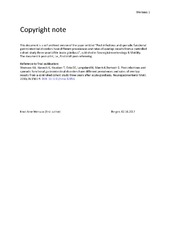Postinfectious and sporadic functional gastrointestinal disorders have different prevalences and rates of overlap: results from a controlled cohort study 3 years after acute giardiasis
Wensaas, Knut-Arne; Hanevik, Kurt; Hausken, Trygve; Eide, Geir Egil; Langeland, Nina; Mørch, Kristine; Rørtveit, Guri
Peer reviewed, Journal article
Accepted version
Permanent lenke
https://hdl.handle.net/1956/16744Utgivelsesdato
2016Metadata
Vis full innførselSamlinger
Originalversjon
https://doi.org/10.1111/nmo.12856Sammendrag
Background: Irritable bowel syndrome (IBS) is a common complication following gastroenteritis, and a high prevalence of postgiardiasis IBS has previously been reported. This study aims to investigate the prevalence, adjusted relative risk (RRadj), and overlap of different functional gastrointestinal disorders (FGID) according to Rome III criteria following infection with Giardia lamblia. Methods: All patients ≥18 years of age with verified giardiasis during an outbreak in 2004, and a control group matched by age and gender, were mailed a questionnaire 3 years later. Key Results: The prevalence of functional dyspepsia (FD) was 25.9% in the exposed and 6.9% in the control group, RRadj: 3.9 (95% confidence intervals [CI]: 3.1–4.8). The prevalence of IBS was 47.9% and 14.3%, respectively, with RRadj: 3.4 (95% CI: 3.0–3.8). Prevalence of other gastrointestinal symptoms ranged from 70.0% vs 39.7% for bloating (RRadj: 1.8) to 8.3% vs 2.9% for nausea (RRadj: 3.0) in the Giardia and the control group, respectively. Among individuals fulfilling criteria for IBS 44% in the exposed group and 29% in the control group also fulfilled criteria for FD. IBS subtypes based on Rome III criteria (stool consistency) showed poor agreement with subtypes based on frequency of bowel movements (Kappa-values: 0.17 and 0.27). Conclusions & Inferences: There were high prevalences and RRs of IBS, FD and other gastrointestinal symptoms following acute giardiasis, and a high degree of overlap between the disorders. The agreement between different IBS subtype criteria varied, and there were also differences between the exposed and control group.
